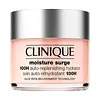What's inside
What's inside
 Key Ingredients
Key Ingredients

 Benefits
Benefits

 Concerns
Concerns

No concerns
 Ingredients Side-by-side
Ingredients Side-by-side

Isononyl Isononanoate
EmollientCamelina Sativa Seed Oil
Skin ConditioningC12-15 Alkyl Benzoate
AntimicrobialMethyl Methacrylate Crosspolymer
Prunus Amygdalus Dulcis Oil
Skin ConditioningWater
Skin ConditioningPropanediol
SolventDi-C20-40 Alkyl Dimer Dilinoleate
Skin ConditioningGlycerin
HumectantParfum
MaskingSorbitan Stearate
EmulsifyingChlorphenesin
AntimicrobialSimmondsia Chinensis Seed Oil
EmollientCaprylic/Capric Triglyceride
MaskingHydrolyzed Hyaluronic Acid
HumectantChlorella Vulgaris Extract
Skin ConditioningTocopherol
AntioxidantAnogeissus Leiocarpa Bark Extract
Skin ConditioningSodium Dehydroacetate
PreservativeHelianthus Annuus Seed Oil
EmollientHydroxypropyl Cyclodextrin
MaskingPhenoxyethanol
PreservativeLinalool
PerfumingCitronellol
PerfumingButylphenyl Methylpropional
PerfumingCananga Odorata Flower Oil
MaskingEugenia Caryophyllus Bud Oil
MaskingPhytosterols
Skin ConditioningLimonene
PerfumingGelidium Cartilagineum Extract
Skin ProtectingHydroxycitronellal
PerfumingPadina Pavonica Thallus Extract
Skin ConditioningGeraniol
PerfumingBenzyl Alcohol
PerfumingEugenol
PerfumingPalmitoyl Tripeptide-38
Skin ConditioningIsononyl Isononanoate, Camelina Sativa Seed Oil, C12-15 Alkyl Benzoate, Methyl Methacrylate Crosspolymer, Prunus Amygdalus Dulcis Oil, Water, Propanediol, Di-C20-40 Alkyl Dimer Dilinoleate, Glycerin, Parfum, Sorbitan Stearate, Chlorphenesin, Simmondsia Chinensis Seed Oil, Caprylic/Capric Triglyceride, Hydrolyzed Hyaluronic Acid, Chlorella Vulgaris Extract, Tocopherol, Anogeissus Leiocarpa Bark Extract, Sodium Dehydroacetate, Helianthus Annuus Seed Oil, Hydroxypropyl Cyclodextrin, Phenoxyethanol, Linalool, Citronellol, Butylphenyl Methylpropional, Cananga Odorata Flower Oil, Eugenia Caryophyllus Bud Oil, Phytosterols, Limonene, Gelidium Cartilagineum Extract, Hydroxycitronellal, Padina Pavonica Thallus Extract, Geraniol, Benzyl Alcohol, Eugenol, Palmitoyl Tripeptide-38
Water
Skin ConditioningDimethicone
EmollientButylene Glycol
HumectantGlycerin
HumectantTrisiloxane
Skin ConditioningTrehalose
HumectantSucrose
HumectantAmmonium Acryloyldimethyltaurate/Vp Copolymer
Hydroxyethyl Urea
HumectantCamellia Sinensis Leaf Extract
AntimicrobialSilybum Marianum Extract
Skin ConditioningBetula Alba Bark Extract
MaskingSaccharomyces Lysate Extract
HumectantAloe Barbadensis Leaf Water
MaskingAloe Barbadensis Leaf Extract
EmollientThermus Thermophillus Ferment
Skin ConditioningCaffeine
Skin ConditioningSorbitol
HumectantPalmitoyl Hexapeptide-12
Skin ConditioningSodium Hyaluronate
HumectantCaprylyl Glycol
EmollientOleth-10
EmulsifyingSodium Polyaspartate
HumectantAloe Barbadensis Leaf Polysaccharides
EmollientLactobacillus Ferment Lysate
Skin ConditioningSaccharide Isomerate
HumectantHydrogenated Lecithin
EmulsifyingTocopheryl Acetate
AntioxidantAcrylates/C10-30 Alkyl Acrylate Crosspolymer
Emulsion StabilisingGlyceryl Polymethacrylate
Tromethamine
BufferingPEG-8
HumectantHexylene Glycol
EmulsifyingMagnesium Ascorbyl Phosphate
AntioxidantCitric Acid
BufferingBHT
AntioxidantDisodium EDTA
Sodium Citrate
BufferingPotassium Sorbate
PreservativeSodium Benzoate
MaskingPhenoxyethanol
PreservativeCI 14700
Cosmetic ColorantCI 19140
Cosmetic ColorantWater, Dimethicone, Butylene Glycol, Glycerin, Trisiloxane, Trehalose, Sucrose, Ammonium Acryloyldimethyltaurate/Vp Copolymer, Hydroxyethyl Urea, Camellia Sinensis Leaf Extract, Silybum Marianum Extract, Betula Alba Bark Extract, Saccharomyces Lysate Extract, Aloe Barbadensis Leaf Water, Aloe Barbadensis Leaf Extract, Thermus Thermophillus Ferment, Caffeine, Sorbitol, Palmitoyl Hexapeptide-12, Sodium Hyaluronate, Caprylyl Glycol, Oleth-10, Sodium Polyaspartate, Aloe Barbadensis Leaf Polysaccharides, Lactobacillus Ferment Lysate, Saccharide Isomerate, Hydrogenated Lecithin, Tocopheryl Acetate, Acrylates/C10-30 Alkyl Acrylate Crosspolymer, Glyceryl Polymethacrylate, Tromethamine, PEG-8, Hexylene Glycol, Magnesium Ascorbyl Phosphate, Citric Acid, BHT, Disodium EDTA, Sodium Citrate, Potassium Sorbate, Sodium Benzoate, Phenoxyethanol, CI 14700, CI 19140
 Reviews
Reviews

Ingredients Explained
These ingredients are found in both products.
Ingredients higher up in an ingredient list are typically present in a larger amount.
Glycerin is already naturally found in your skin. It helps moisturize and protect your skin.
A study from 2016 found glycerin to be more effective as a humectant than AHAs and hyaluronic acid.
As a humectant, it helps the skin stay hydrated by pulling moisture to your skin. The low molecular weight of glycerin allows it to pull moisture into the deeper layers of your skin.
Hydrated skin improves your skin barrier; Your skin barrier helps protect against irritants and bacteria.
Glycerin has also been found to have antimicrobial and antiviral properties. Due to these properties, glycerin is often used in wound and burn treatments.
In cosmetics, glycerin is usually derived from plants such as soybean or palm. However, it can also be sourced from animals, such as tallow or animal fat.
This ingredient is organic, colorless, odorless, and non-toxic.
Glycerin is the name for this ingredient in American English. British English uses Glycerol/Glycerine.
Learn more about GlycerinPhenoxyethanol is a preservative that has germicide, antimicrobial, and aromatic properties. Studies show that phenoxyethanol can prevent microbial growth. By itself, it has a scent that is similar to that of a rose.
It's often used in formulations along with Caprylyl Glycol to preserve the shelf life of products.
Water. It's the most common cosmetic ingredient of all. You'll usually see it at the top of ingredient lists, meaning that it makes up the largest part of the product.
So why is it so popular? Water most often acts as a solvent - this means that it helps dissolve other ingredients into the formulation.
You'll also recognize water as that liquid we all need to stay alive. If you see this, drink a glass of water. Stay hydrated!
Learn more about Water